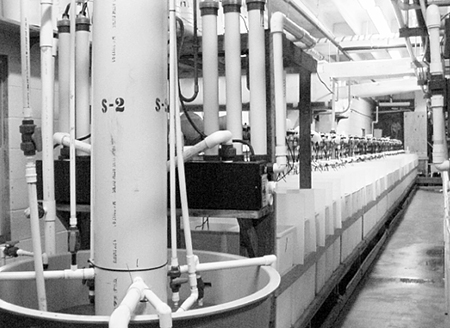Recirculating-system research conducted at Texas A&M

Among lipids, some omega-3 and omega-6 polyunsaturated fatty acids (PUFA) such as linolenic (18:3 omega-3) and linoleic (18:2 omega-6) acid, as well as highly unsaturated fatty acids (HUFA) such as arachidonic (20:4 omega-6), eicosapentaenoic (20:5omega -3), and docosahexaenoic (22:6 omega-3) acid are considered essential nutrients for penaeid shrimp. In spite of this, knowledge of the dietary requirements for these nutrients in Pacific white shrimp (Litopenaeus vannamei), an economically important penaeid for shrimp farming in the Americas, is limited.
The authors conducted a six-week experiment at the Shrimp Mariculture Project of Texas A&M University in Port Aransas, Texas, USA to test the dietary inclusion of 18:3 omega-3, 18:2 omega-6, 20:4 omega-6, 20:5 omega-3, and 22:6 omega-3 fatty acids at 0.5 percent of diet. An additional diet contained 0.5 percent of an omega-3 HUFA mix, which included 416 milligrams per gram of 20:522:6 omega-3-3 and 237 milligrams per gram of 22:6 omega-3. A basal diet contained only palmitic (16:0) and stearic (18:0) acid, also used as fillers for a 5 percent total dietary lipid.
L. vannamei juveniles with a mean initial weight of 0.4 grams were stocked at 44.4 animals per square meter into 10, 32-liter replicate tanks per dietary treatment. The indoor aerated recirculating system was kept at a temperature of 30 degrees-C and a salinity of 25 ppt.
Shrimp growth and survival

Differences in weight gain of shrimp were observed at the end of the feeding trial (Fig. 1). HUFA like 20:4 omega-6, 20:5 omega-3, and 22:6 omega-3, as well as the omega-3 HUFA mix, showed higher nutritional value than PUFA like 18:3 omega-3 and 18:2 omega-6 for juvenile L. vannamei.
Neither 18:3 omega-3 or 18:2 omega-6 improved shrimp growth significantly when compared to animals fed the basal diet with 16:0 and 18:0 only. Survival of shrimp averaged almost 94 percent and was not significantly affected by the dietary treatments.
Conclusion
As demonstrated for juvenile L. vannamei in the study, HUFA generally show higher nutritive value than PUFA. However, no preferential activity as essential fatty acids was observed for the omega-3 over the n-6 family of fatty acids under our experimental conditions, as different reports have indicated.
Results suggested that for L. vannamei, the essential fatty acid value may be determined by chain length and degree of unsaturation, with long-chain unsaturated fatty acids having greater nutritional value than shorter-chain fatty acids, regardless of the family to which they belong.
(Editor’s Note: This article was originally published in the October 2002 print edition of the Global Aquaculture Advocate.)
Now that you've finished reading the article ...
… we hope you’ll consider supporting our mission to document the evolution of the global aquaculture industry and share our vast network of contributors’ expansive knowledge every week.
By becoming a Global Seafood Alliance member, you’re ensuring that all of the pre-competitive work we do through member benefits, resources and events can continue. Individual membership costs just $50 a year. GSA individual and corporate members receive complimentary access to a series of GOAL virtual events beginning in April. Join now.
Not a GSA member? Join us.
Authors
-
Mayra Lizett González-Félix, Ph.D.
Departmento de Investigaciones Científicas y Tecnológicas
Universidad de Sonora
Rosales y Niños Héroes
A.P. 1819 C.P. 83000
Hermosillo, Sonora, México -
Martin Perez-Velazquez, Ph.D.
Departmento de Investigaciones Científicas y Tecnológicas
Universidad de Sonora
Rosales y Niños Héroes
A.P. 1819 C.P. 83000
Hermosillo, Sonora, México -
Addison L. Lawrence, Ph.D.
Texas A&M University
Shrimp Mariculture Project
Port Aransas, Texas, USA -
Delbert M. Gatlin III, Ph.D.
Department of Wildlife and Fisheries Sciences
Texas A&M University
College Station, Texas, USA
Tagged With
Related Posts

Aquafeeds
Aquafeed moonshots at the F3 ‘talent show’
At the F3 (fish-free feed) Companies Got Talent event in Burlingame, Calif., last week, alternative (non-marine) aquafeed ingredient companies spoke of decoupling aquaculture from fishmeal and fish oil in their quest for greater sustainability.

Health & Welfare
Dietary effects of fish oil, soy lecithin on shrimp in clear and greenwater systems
A 56-day trial conducted in greenhouse-enclosed clearwater and greenwater systems compared tissue variations among shrimp fed varied dietary levels of fish oil and soy lecithin.

Health & Welfare
Fatty acids in feeds improve growth, lipid profiles of white shrimp farmed at high salinity
A study showed that lipid source and DHA and EPA levels in feeds can influence the growth performance and tail fatty acid profiles of L. vannamei farmed under hypersaline conditions.

Aquafeeds
Fish oil alternatives are waiting in the wings
The Future of Fish Feed (F3) initiative aims to jumpstart innovation in terms of viable fish-free substitutes to fish oil through the global F3 Fish Oil Challenge.


